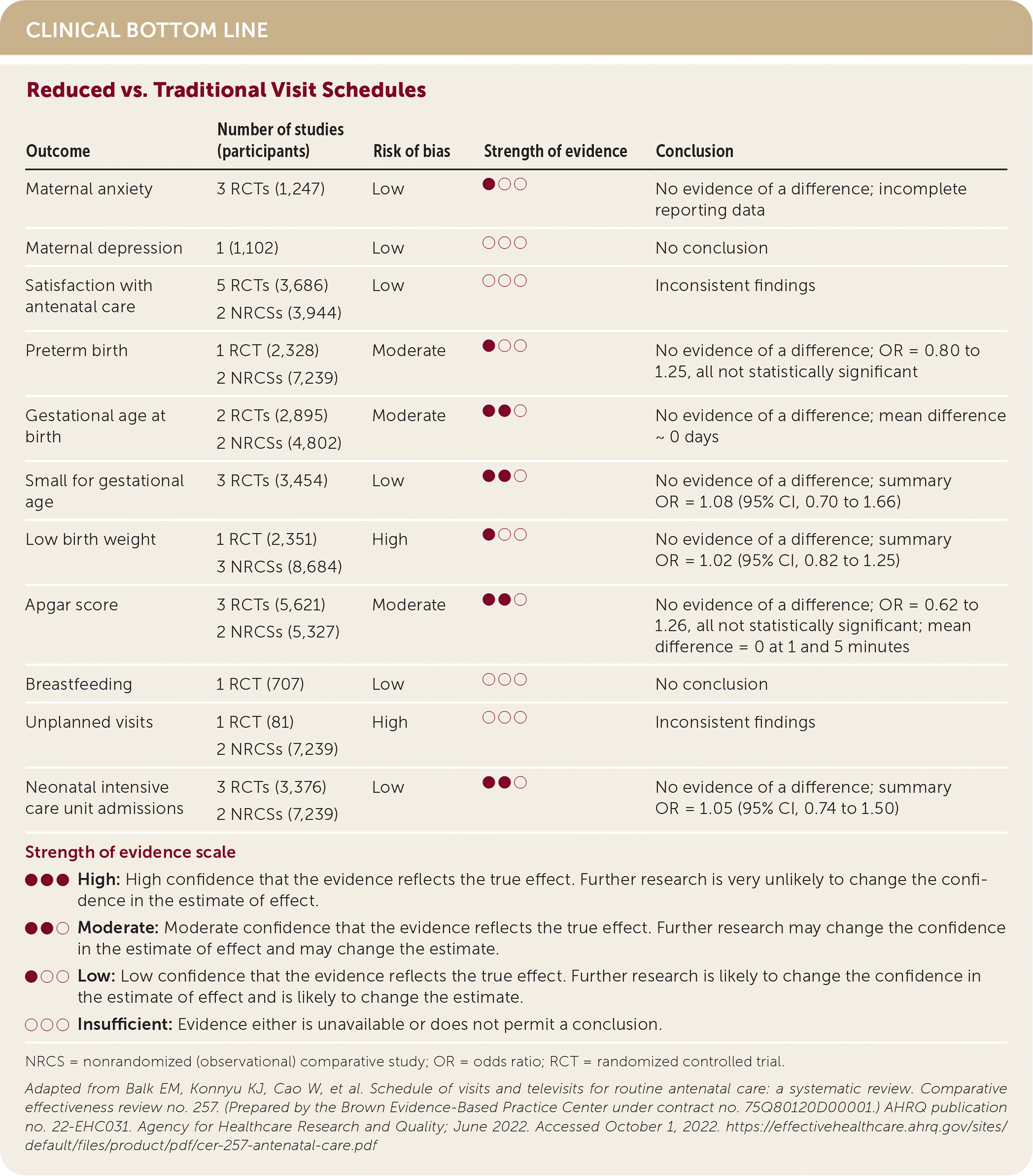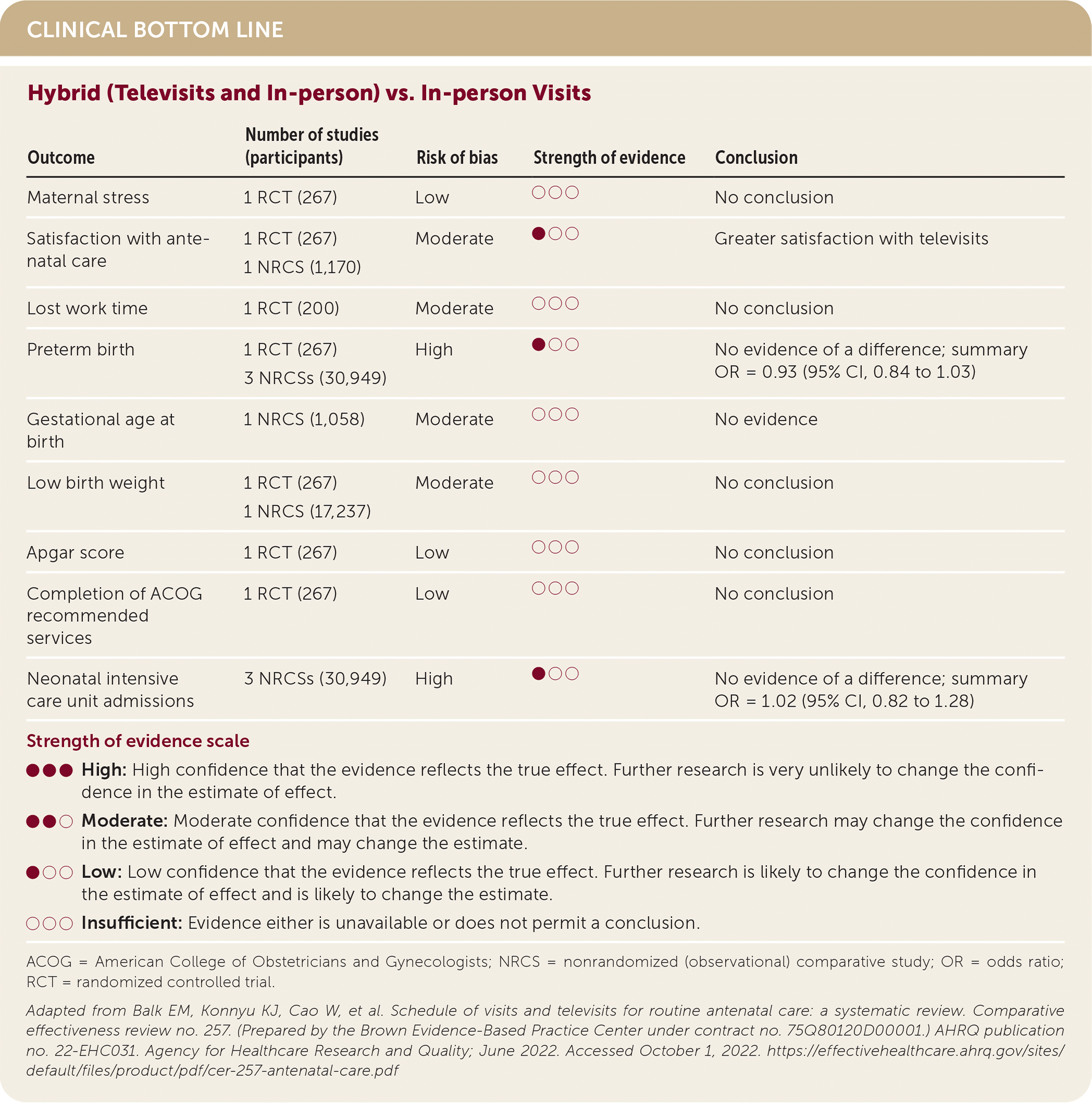
Am Fam Physician. 2023;107(2):187-190
Author disclosure: No relevant financial relationships.
Key Clinical Issue
What are the risks and benefits of less frequent antenatal in-person visits vs. traditional visit schedules and televisits replacing some in-person antenatal appointments?
Evidence-Based Answer
Compared with traditional schedules of antenatal appointments, reducing the number of appointments showed no difference in gestational age at birth (mean difference = 0 days), likelihood of being small for gestational age (odds ratio [OR] = 1.08; 95% CI, 0.70 to 1.66), likelihood of a low Apgar score (mean difference = 0 at one and five minutes), likelihood of neonatal intensive care unit (NICU) admission (OR = 1.05; 95% CI, 0.74 to 1.50), maternal anxiety, likelihood of preterm birth (nonsignificant OR), and likelihood of low birth weight (OR = 1.02; 95% CI, 0.82 to 1.25). (Strength of Recommendation [SOR]: B, inconsistent or limited-quality patient-oriented evidence.) Studies comparing hybrid visits (i.e., televisits and in-person) with in-person visits only did not find differences in rates of preterm births (OR = 0.93; 95% CI, 0.84 to 1.03; P = .18) or rates of NICU admissions (OR = 1.02; 95% CI, 0.82 to 1.28). (SOR: B, inconsistent or limited-quality patient-oriented evidence.) There was insufficient evidence to assess other outcomes.1
Practice Pointers
Antenatal care is a cornerstone of obstetric practice in the United States, and millions of patients receive counseling, screening, and medical care in these visits.2,3 There is clear evidence supporting the benefits of antenatal care; however, the number of appointments needed and setting of visits is less understood.
The American College of Obstetricians and Gynecologists recommends antenatal visits every four weeks until 28 weeks' gestation, every two weeks until 36 weeks' gestation, and weekly thereafter, which typically involves 10 to 12 visits.4
Expert consensus and past meta-analyses have favored fewer antenatal care visits given similar maternal and neonatal outcomes. In 1989, the U.S. Public Health Service suggested a reduction in the antenatal visit schedule based on a multidisciplinary panel and expert opinion in conjunction with a literature review; however, the American College of Obstetricians and Gynecologists has not updated its guidelines, and practices have not changed.5 A 2010 Cochrane review found no differences in perinatal mortality between patients randomized to higher vs. reduced antenatal care groups in high-income countries, and a 2015 Cochrane review showed no difference in neonatal outcomes for women in high-income countries.6,7
The Agency for Healthcare Research and Quality (AHRQ) review showed moderate- and low-strength evidence and did not find significant differences between traditional and abbreviated schedules when looking at many outcomes, such as gestational age at birth, low birth weight, Apgar scores, NICU admission, preterm birth, and maternal anxiety. The review was limited by a small evidence base with studies that are difficult to compare. The randomized controlled trials that were eligible were adjusted for confounding, whereas the nonrandomized controlled studies were not adjusted and were at high risk for confounding.
Telemedicine, defined as the use of electronic information and telecommunication to support health care among patients, clinicians, and administrators, is a new option for antenatal care delivery.8 Televisits, the real-time communication between patients and clinicians via phone or the internet, are the specific interactions that encompass telemedicine. Recent literature suggests that supplementing in-person visits with televisits in low-risk pregnancies resulted in similar clinical outcomes and higher patient satisfaction scores.9 The AHRQ review found no significant differences between rates of preterm births or NICU admissions for a hybrid model of televisits and in-person visits compared with in-person visits only. The review was limited due to the lack of adjustments for potential confounders in the study. For example, some of the studies were conducted during the COVID-19 pandemic, which adds multiple confounders and potential for bias.
The AHRQ review offers limited opportunity for conclusions to suggest changes in current practice. The current evidence supports past evidence, suggesting that fewer visits are not associated with neonatal or maternal harm, and televisits may have a role in antenatal care. Many of the other outcomes of interest had insufficient evidence to generate conclusions.

| Outcome | Number of studies (participants) | Risk of bias | Strength of evidence | Conclusion |
|---|---|---|---|---|
| Maternal anxiety | 3 RCTs (1,247) | Low | ● ○ ○ | No evidence of a difference; incomplete reporting data |
| Maternal depression | 1 (1,102) | Low | ○ ○ ○ | No conclusion |
| Satisfaction with antenatal care | 5 RCTs (3,686) 2 NRCSs (3,944) | Low | ○ ○ ○ | Inconsistent findings |
| Preterm birth | 1 RCT (2,328) 2 NRCSs (7,239) | Moderate | ● ○ ○ | No evidence of a difference; OR = 0.80 to 1.25, all not statistically significant |
| Gestational age at birth | 2 RCTs (2,895) 2 NRCSs (4,802) | Moderate | ● ● ○ | No evidence of a difference; mean difference ~ 0 days |
| Small for gestational age | 3 RCTs (3,454) | Low | ● ● ○ | No evidence of a difference; summary OR = 1.08 (95% CI, 0.70 to 1.66) |
| Low birth weight | 1 RCT (2,351) 3 NRCSs (8,684) | High | ● ○ ○ | No evidence of a difference; summary OR = 1.02 (95% CI, 0.82 to 1.25) |
| Apgar score | 3 RCTs (5,621) 2 NRCSs (5,327) | Moderate | ● ● ○ | No evidence of a difference; OR = 0.62 to 1.26, all not statistically significant; mean difference = 0 at 1 and 5 minutes |
| Breastfeeding | 1 RCT (707) | Low | ○ ○ ○ | No conclusion |
| Unplanned visits | 1 RCT (81) 2 NRCSs (7,239) | High | ○ ○ ○ | Inconsistent findings |
| Neonatal intensive care unit admissions | 3 RCTs (3,376) 2 NRCSs (7,239) | Low | ● ● ○ | No evidence of a difference; summary OR = 1.05 (95% CI, 0.74 to 1.50) |
| Strength of evidence scale | ||||
| ● ● ● High: High confidence that the evidence reflects the true effect. Further research is very unlikely to change the confidence in the estimate of effect. | ||||
| ● ● ○ Moderate: Moderate confidence that the evidence reflects the true effect. Further research may change the confidence in the estimate of effect and may change the estimate. | ||||
| ● ○ ○ Low: Low confidence that the evidence reflects the true effect. Further research is likely to change the confidence in the estimate of effect and is likely to change the estimate. | ||||
| ○ ○ ○ Insufficient: Evidence either is unavailable or does not permit a conclusion. | ||||

| Outcome | Number of studies (participants) | Risk of bias | Strength of evidence | Conclusion |
|---|---|---|---|---|
| Maternal stress | 1 RCT (267) | Low | ○ ○ ○ | No conclusion |
| Satisfaction with antenatal care | 1 RCT (267) 1 NRCS (1,170) | Moderate | ● ○ ○ | Greater satisfaction with televisits |
| Lost work time | 1 RCT (200) | Moderate | ○ ○ ○ | No conclusion |
| Preterm birth | 1 RCT (267) 3 NRCSs (30,949) | High | ● ○ ○ | No evidence of a difference; summary OR = 0.93 (95% CI, 0.84 to 1.03) |
| Gestational age at birth | 1 NRCS (1,058) | Moderate | ○ ○ ○ | No evidence |
| Low birth weight | 1 RCT (267) 1 NRCS (17,237) | Moderate | ○ ○ ○ | No conclusion |
| Apgar score | 1 RCT (267) | Low | ○ ○ ○ | No conclusion |
| Completion of ACOG recommended services | 1 RCT (267) | Low | ○ ○ ○ | No conclusion |
| Neonatal intensive care unit admissions | 3 NRCSs (30,949) | High | ● ○ ○ | No evidence of a difference; summary OR = 1.02 (95% CI, 0.82 to 1.28) |
| Strength of evidence scale | ||||
| ● ● ● High: High confidence that the evidence reflects the true effect. Further research is very unlikely to change the confidence in the estimate of effect. | ||||
| ● ● ○ Moderate: Moderate confidence that the evidence reflects the true effect. Further research may change the confidence in the estimate of effect and may change the estimate. | ||||
| ● ○ ○ Low: Low confidence that the evidence reflects the true effect. Further research is likely to change the confidence in the estimate of effect and is likely to change the estimate. | ||||
| ○ ○ ○ Insufficient: Evidence either is unavailable or does not permit a conclusion. | ||||
Editor's Note: American Family Physician SOR ratings are different from the AHRQ Strength of Evidence ratings.
The opinions and assertions contained herein are the private views of the authors and are not to be construed as official or as reflecting the views of the U.S. Army, the U.S. Department of Defense, or the U.S. government.
For the full review, go to https://effectivehealthcare.ahrq.gov/sites/default/files/product/pdf/cer-257-antenatal-care.pdf.

